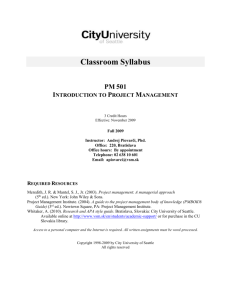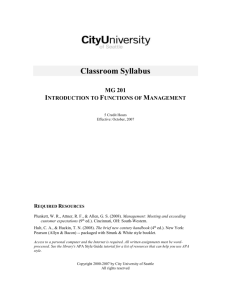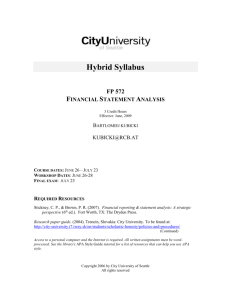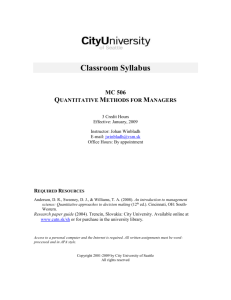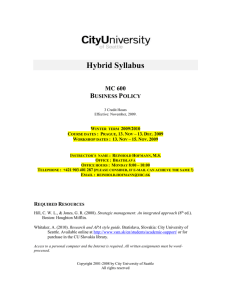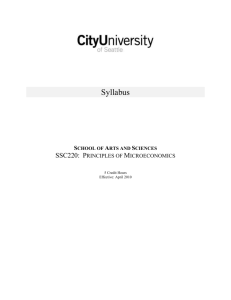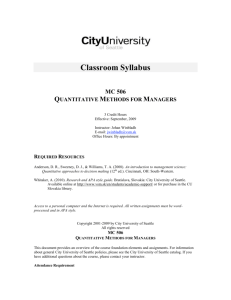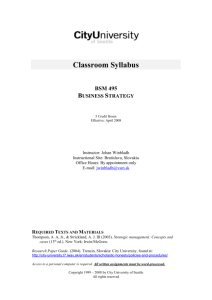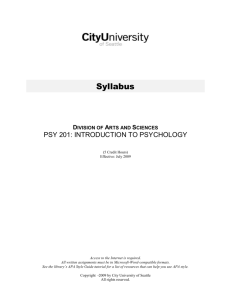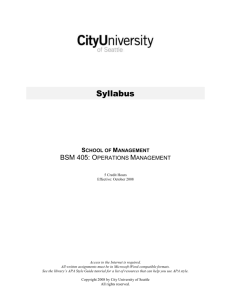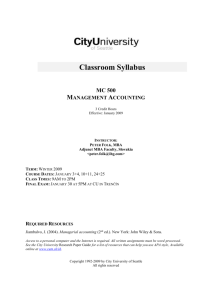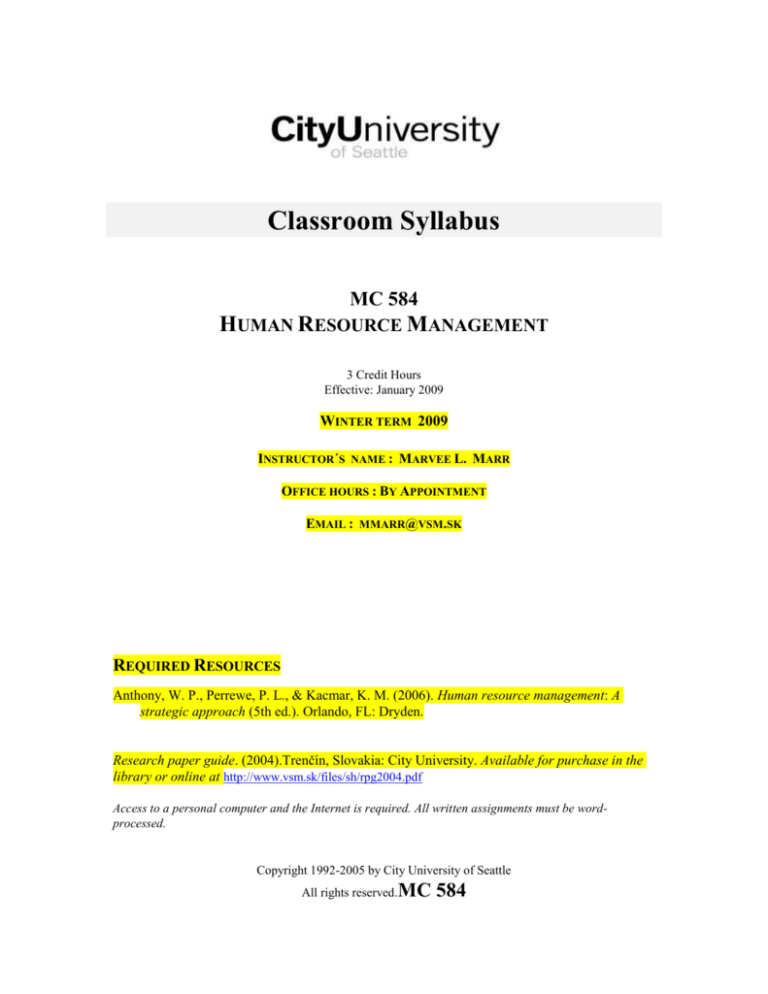
Classroom Syllabus
MC 584
HUMAN RESOURCE MANAGEMENT
3 Credit Hours
Effective: January 2009
WINTER TERM 2009
INSTRUCTOR´S NAME : MARVEE L. MARR
OFFICE HOURS : BY APPOINTMENT
EMAIL : MMARR@VSM.SK
REQUIRED RESOURCES
Anthony, W. P., Perrewe, P. L., & Kacmar, K. M. (2006). Human resource management: A
strategic approach (5th ed.). Orlando, FL: Dryden.
Research paper guide. (2004).Trenčín, Slovakia: City University. Available for purchase in the
library or online at http://www.vsm.sk/files/sh/rpg2004.pdf
Access to a personal computer and the Internet is required. All written assignments must be wordprocessed.
Copyright 1992-2005 by City University of Seattle
All rights reserved.
MC 584
HUMAN RESOURCE MANAGEMENT
This document provides an overview of the course foundation elements, assignments, schedules,
and activities. For information about general City University of Seattle policies, please see the
City University of Seattle catalog. If you have additional questions about the course, please
contact your instructor.
Notification to Students with Disabilities
If you are a student with a disability and you require certain help, please contact the site
administrator as soon as possible.
Scholastic Honesty
City University of Seattle expects each student to do his/her own work. The University has "zero tolerance"
for cheating, plagiarism, unauthorized collaboration on assignments and papers, using "notes" during
exams, submitting someone else's work as one's own, submitting work previously submitted for another
course, or facilitating acts of academic dishonesty by others. The penalties are severe! A first offense can
result in a zero grade for the course and suspension for one quarter; a second offense can result in a zero
grade for the course and suspension for two or more quarters; a third offense can result in expulsion from
the University. The Policy and Procedures may be found at http://www.vsm.sk/en/students/scholastichonesty/policies-and-procedures/.
In addition to providing your work to the instructor for grading, you must also submit an
electronic copy for the CU archives (unless the work is specifically exempted by the instructor).
You will not receive a grade for particular work until and unless you submit this electronic copy.
The procedure for submitting work to the archives is to upload it via the website
http://www.vsm.sk/en/students/on-line-center/uploader/uploader.html. Files should include the cover
page of the work with the student name, instructor name, course name and number, and date.
File names should indicate the type of assignment, such as “researchpaper.doc”, “casestudy.doc”
or “ thesis.doc” (student name should not be a part of the file name because the system adds it).
All files received into the archives are submitted to www.TurnItIn.com for plagiarism checking.
COURSE DESCRIPTION
This course covers the optimum organization and employment of human resources to accomplish
strategic organizational objectives; personnel functions in recruitment, selection, training,
promotion and succession planning; relevant behavioral research; legal environment; comparison
and contrast of the public and private sectors.LEARNING GOALS
Upon the successful completion of this course, you will be able to:
1. Design a HR strategic plan that supports the mission, goals, and strategies of an organization;
2. Analyze different writers’ attitudes, biases, and arguments relating to various topics on
human resources;
3. Evaluate ethical considerations which face human resource professionals and line managers
as they relate to employee rights and employer responsibilities;
MC 584
SYL
Page 2
Eff: 10/05
4. Compare and contrast the recruitment, training, and the development roles in human resource
planning;
5. Determine from the strategic plan of an organization, appropriate compensation, and benefit
programs;
6. Critique the role of human resources in today's organization;
7. Describe effective communication strategies as they relate to the human resource function
and performance feedback;
8. Assess challenges facing human resource managers and professionals in the area of
performance management and employee retention;
9. Evaluate the impact of globalization on an organization's human resource policies and
practices.
CORE CONCEPTS
To achieve the goals of this course, you will need to master the following core concepts:
1. Strategic approach to human resource management;
2. Corporate and human resource strategy;
3. The external and global environment for human resources;
4. Human resource planning and information systems;
5. Equal Employment Opportunity;
6. Job analysis;
7. Recruitment, selection, and retention;
8. Job design;
9. Orientation, training, and development;
10. Strategies for effective performance appraisal systems;
11. Strategic compensation systems;
12. Improving productivity;
13. Benefit plans;
14. Managing health, safety, and stress;
15. Ethics, employee rights, and employer responsibilities;
16. Unions and strategic collective bargaining;
17. Separation restructuring and the virtual organization.
CLASSROOM POLICIES:
MC 584
SYL
Page 3
Eff: 10/05
-NO LATE WORK IS ACCEPTED (WORK MAY BE TURNED IN EARLY)
-NO MAKE- UP EXAMS WILL BE GIVEN
-PLEASE BE ON TIME TO CLASS
-PLEASE BE PREPARED FOR CLASS
-PLEASE RESPECT THE CLASSROOM AND YOUR PEERS (LISTEN, TURN OF CELL PHONES, ETC)
RECOMMENDED SUPPLEMENTARY RESOURCES
As a City University of Seattle student, you have access to library resources regardless of where and how
you are taking this class. To access the resources necessary to complete your coursework, visit the library
menu in the My.CityU portal at https://my.cityu.edu, and the CU Slovakia library home page at
http://library.cutn.sk/.
A good place to begin your research is through the management program resources page in the My.CityU
library. It provides links to relevant journals, books, and Web sites. Search the online databases for journal,
magazine, and newspaper articles. For additional help, visit the Slovakia library or submit your question in
the Contact Us section of the Slovakia library’s web site.
PRINT RESOURCES
Baron, J. N., & Kreps, D. M. (1999). Strategic human resources: Frameworks for general
managers. New York: John Wiley & Sons, Inc.
Bunker, B. B., & Alban, B. (1996). Large group interventions: Engaging the whole system for
rapid change. San Francisco: Jossey-Bass.
Hilgert, R. L., & Schoen, S. H. (1996). Cases in collective bargaining and industrial relations
(8th ed.). Chicago: Irwin.
Hoecklin, L. (1994). Managing cultural differences: Strategies for competitive advantage.
Reading, MA: Addison-Wesley.
Kleiman, L. S. (2000). Human resource management: A managerial tool for competitive
advantage (2nd ed.). Cincinnati, OH: South-Western College Publishing.
Kotter, J. P. (1996). Leading change. Boston: Harvard Business School Press.
Kroeck, G., & Fraser, S. (1994). Tactical experiences in human resources. Orlando, FL: Dryden.
Martocchio, J. J. (2001). Strategic compensation: A human resource management approach
(2nd ed.). Upper Saddle River, NJ: Prentice-Hall, Inc.
Milkovich, G. T., & Newman, J. M. (1996). Compensation (5th ed.). Chicago: Irwin.
Noe, R. A., Hollenbeck, J. R., Gerhart, B., & Wright, P. M. (1994). Readings in human resource
management. Burr Ridge, IL: Irwin.
Pinchot, G., & Pinchot, E. (1996). The intelligent organization: Engaging the talent and
initiative of everyone in the workplace. San Francisco: Barrett-Koehler.
Rue, L. W., & Byers, L. L. (2001) Supervision: Key link to productivity (7th ed.). New York:
McGraw-Hill.
Smith, D. K. (1996). Taking charge of change: 10 principles for managing people and
performance. Reading, MA: Addison-Wesley.
MC 584
SYL
Page 4
Eff: 10/05
Wilson, T. B. (1994). Innovative reward systems for the changing workplace. New York:
McGraw-Hill.
The following are professional journals that feature scholarly articles of substantial length on
Human Resource Management.
Academy of Management and
Business Horizons
Executive Review
Harvard Business Review
Academy of Management Review
Human Resource Planning Journal
Academy of Management and
Journal of Human Resources
Executive Review
Personnel Journal
American Business Law Journal
Sloan Management Review
Administrative Science Quarterly
ELECTRONIC RESOURCES
The following general Internet World Wide Web resources may be of use to you in this course.
Please be aware that Web addresses may change from time to time. Consult your instructor if you
have questions about electronic resources.
American Staffing Association (association for staffing services firms)
http://www.staffingtoday.org
The APA Publication Manual Crib Sheet
http://www.gasou.edu/psychweb/tipsheet/apacrib.html
Argus Clearinghouse (Internet research library)
http://www.clearinghouse.net
BRINT - A Business Researcher’s Interests
http://brint.com
City University of Seattle
http://my.cityu.edu
Harvard Business School Publishing (abstracts for HBR cases, etc.)
http://www.hbsp.harvard.edu
Human Resource Management Resources on the Internet This is a list of Internet
resources relevant to Human Resource Management. Sub categories include general HR
links, employee relations, business psychology, human resource publications,
organization and management theory, business ethics, HR training and development and
much more.
http://www.nbs.ntu.ac.uk/staff/lyerj/hrm_link.htm
IHRIM International Association for Human Resource Information Management
http://www.ihrim.org
Internet Resource Page (Extensive links to Internet resources)
http://www.nyu.edu/classes/Keating/tinter.htm
IOMA Institute of Management and Administration
http://www.ioma.com
MC 584
SYL
Page 5
Eff: 10/05
IPMA International Personnel Management Association
http://www.ipma-hr.org
The Legal Information Institute (Legal information and court decisions, etc.)
http://www.law.cornell.edu
Management Archive (forum for management ideas and information)
http://ursus.jun.alaska.edu
Nijenrode Business Webserver List of Human Resource Management and Organizational
Behavior links put together by Nijenrode University, the Netherlands business School
http://www.nijenrode.nl/nbr/hrm
SHRM Online The Society for Human Resource Management is the leading voice of
human resource professionals. This site includes HR news online, HR bulletin boards,
HR links, HR Magazine and more.
http://www.shrm.org,
Uncover Via WWW (UnCover is an on-line article delivery service, a table of contents
database, and a keyword index to nearly 17,000 periodicals)
http://www.carl.org/uncover/unchome.html
Workforce Online (The web site for business leaders in Human Resources. Includes
library of articles on HR topics)
http://www.workforceonline.com
WWW Business Related Resources
HTTP://SBED.UMN.EDU/RESOURCE/RESOURCE/HTMLOVERVIE
W OF COURSE ACTIVITIES AND GRADING
The grade you receive for the course will be derived using City University of Seattle’s decimal
grading system, based on the following:
Assignments
Presentation
Classroom activities
Team Case Analysis
Human Resource Project (team)
Final Examination
10%
10%
20%
30%
30%
TOTAL
100%
Please consult with your instructor and the current City University of Seattle Catalog for
guidance in determining your decimal grade.
EXPLANATION OF ASSIGNMENTS
TEAM CASE ANALYSIS
MC 584
SYL
Page 6
Eff: 10/05
I will assign a case or give you guidelines to use in selecting a case for analysis. A case analysis
is designed to help you sharpen your analytical skills. The most effective way to analyze a case is
to apply a variation of the scientific method. This method of analysis is simply a logical approach
that usually includes the seven steps outlined below.
Step 1: Problem Definition
A case seldom involves one clear-cut problem. Your task is to:
determine the symptoms, which require immediate attention.
identify the fundamental issues and causal factors giving rise to these symptoms.
It is important to separate the immediate problems from their more basic causes. For example,
the immediate problem may be a high rate of absenteeism, while the more fundamental issue may
be a poor motivational climate. How you define a problem determines how you go about solving
it. A short-term solution for absenteeism is likely to be different from solutions, which attempt to
deal with motivational climate. Be sure to identify both the symptom and, more importantly, its
underlying cause.
Step 2: Justification for Problem Definition
In this step you need to review the information you have about the problem. You may need to
make some inferences to fill in gaps. Clearly label what is inference and what is factual. Do not
be afraid to assume, but clearly state the assumptions you are making. You should make
assumptions on the basis of your knowledge of typical managerial practices, and they should be
consistent with the facts about the case, even though your facts may be somewhat limited.
Managerial decisions are often based on limited information. In fact, practicing managers find
that many of their decisions have to be made quickly on the basis of limited information.
Step 3: List Alternative Courses of Action
Be creative. Jot down ideas as they come to you. List as many ideas as you can without
evaluating them or censoring anything. You can always cross them out later. The point is to let
your imagination take over. Only three alternatives should be listed on the paper you turn in and
one should NOT be “do nothing”.
Step 4: Evaluate Alternatives
Look critically at the alternatives you came up with in Step 3. List advantages and disadvantages
of each alternative in terms of criteria that seem appropriate.
Step 5: Review
Reread your notes and think. This may be a good time to let the case sit for a while. Get back to
it later when you have a chance to digest all the data.
Step 6: Draw Conclusions, Make Recommendations/Decisions
Select the alternative you would recommend and explain/justify your choice. Include specifics
about the implementation of your recommendation: who should do what, when, and how.
Step 7: Follow Up and Evaluate
MC 584
SYL
Page 7
Eff: 10/05
Given the limitations of a classroom setting, you cannot implement your recommendation and
evaluate its actual impact. However, in this step you will describe how you would set up an
evaluation procedure. Suggest a timetable and methods for the evaluation process. State who
should do the evaluating.
Source: Myers, T. & Myers, G. (1982). Managing by communication: An organizational approach. New York: McGraw-Hill Book.
The body of the paper will be at least eight pages, double spaced. Any sources must be cited
within the body of the paper using the American Psychological Association (APA) style. You
must include a list of references in APA style with your paper.
Your team will present your analysis of a case to the rest of the class.
Grading Criteria for Team Case Analysis
Integration of course concepts
Completeness of analysis
Logically supported conclusions and recommendations
Sufficient bibliographic support
Proper grammar, spelling, punctuation, and style
APA
20%
30%
20%
10%
10%
10%
TOTAL for Team Case Analysis
100%
Team Evaluation
Team members will evaluate each other according to the following criteria:
Making and keeping agreements
Encouraging and supporting team members
Utilizing a variety of task and maintenance roles
Managing conflict effectively
25%
25%
25%
25%
TOTAL for team evaluation portion of Team Case Analysis
100%
HUMAN RESOURCE PROJECT
Option # 1
Using one organization with which you are familiar, describe how human resources currently
functions as a strategic business partner in two major areas of business, e.g., employee selection,
HRIS systems, labor relations, training. Once you have described the current situation, make
recommendations on how human resources could function more effectively as a strategic
business partner. In proposing your recommendations, you must conduct thorough research to
justify your proposed changes.
MC 584
SYL
Page 8
Eff: 10/05
Option # 2
Using two organizations in a particular field of business, e.g., computers, manufacturing, and
retailing, analyze future human resource trends with regard to business strategy. Compare and
contrast how each is moving into the future. Describe and analyze the impact of virtual human
resource management on the business strategy of the company.
Option # 3
Select two areas of human resource management in a particular company. Focus on federal and
state employment law. How has the strategy of the company developed to accommodate
employment legislation and landmark court cases, e.g., ADA and Affirmative Action?
Your Human Resources Project should include the following components:
A Cover Page
Your cover page should include your name, title of assignment, date, course number and
course title.
How Human Resources Currently Functions as a Strategic Business Partner
This is a description of the current situation in which you will identify strategic
approaches currently being used. Be specific in your description.
How Human Resources Can More Effectively Function as a Strategic Business Partner
You must identify specific ways in which Human Resources can function more
effectively as a strategic business partner. Be realistic, but also be creative.
Justification for Recommendations
This is where you will utilize most of your outside research. You must justify the
recommendations you have made. Defend your arguments by using supporting evidence.
Unless your instructor states otherwise, you must use a minimum of five sources
published within the last four years. Sources must be cited within the body of the paper
using the American Psychological Association (APA) style.
Reference List
Reference List must conform to APA style.
The body of the paper will be at least fifteen pages, double-spaced.
Grading Criteria for Assignment #2 Human Resource Project
Description of how human resources currently functions
Recommendations on how human resources could function
more effectively
Justification for proposed recommendations
Bibliographical support substantiating arguments
MC 584
SYL
Page 9
Eff: 10/05
25%
30%
25%
10%
Proper grammar, spelling, punctuation, and APA style
10%
TOTAL
100%
Examination
You should be prepared to answer a variety of types of questions pertinent to the concepts
covered in or suggested by the course materials, assignments, and activities. Your instructor may
provide you with additional information about the content, style, and grading criteria of the
examination.
Grading Criteria for Essay Questions on Final Examination
Clear demonstration of grasp of major issues
Valid arguments and appropriate supportive detail
Appropriate analysis, evaluation, and synthesis
Demonstration of ability to employ terms, concepts, and
frames of reference from texts and other course materials
Proper organization and logical flow of response
20%
20%
20%
20%
TOTAL
100%
20%
Course Schedule
The schedule for course activities and assignments is below. If you find you are unable to
complete the assignments as scheduled, contact your instructor. Changes may occur.
SESSION TOPICS AND ASSIGNMENTS
1
Saturday,
January 3
2
Sunday,
January 4
READINGS
Course Introduction and Overview
Course Requirements
The Strategic Approach to Human Resource
Management
Formulating a Corporate and Human Resource Strategy
The External and Global Environment for Human
Resources: Change and Diversity Change and
Diversity
Assign Teams and Cases/ Discuss HR Project
Chapter 1
Human Resource Planning and Information Systems
Equal Employment Opportunity
Job Analysis
Chapter 4
Chapter 5
Chapter 6
MC 584
SYL
Page 10
Eff: 10/05
Chapter 2
Chapter 3
Recruitment, Selection and Retention
Chapter 7
Job Design
3
Saturday, Orientation, Training, and Development
January 10 Strategies for Effective Performance Appraisal Systems
Due: Proposal for HR Project Due (class)
Chapter 8
Chapter 9
Chapter 10
Strategic Compensation Systems
4
Improving Productivity
Sunday,
January 11 Benefit Plans
Chapter 11
Chapter 12
Chapter 13
DUE: Case Analysis uploaded by Midnight Sunday
Chapter 14
Chapter 15
5
Safety and Stress
Saturday, Ethics and Employee Rights
January 24
6
Team Presentations (HR Project)
Sunday,
January 25
Friday,
Final Exam
January 30 Due: Human Resource Project uploaded by noon
Friday.
Due: Team evaluation form uploaded by 5pm Friday
MC 584
SYL
Page 11
Eff: 10/05

